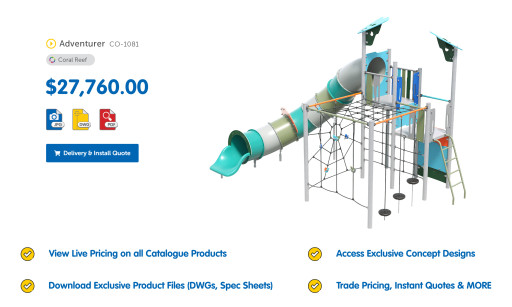Searching...
Success Stories & Insights The Moduplay Group, Australia's largest privately-owned manufacturer of commercial playground equipment, is proud to announce a strategic partnership with Queensland-based...
Play & Development Creating inclusive spaces through sensory gardens Sensory gardens are outdoor environments designed to invite interaction through sight, touch, sound, smell...
Sustainability & Innovation Moduplay Welcomes Federal Government Support for Future Made in Australia The Moduplay Group has welcomed the Federal Government’s commitment to...
Playground Design & Planning Resources Designing Playgrounds Beyond the Big Unit Not every playground needs to be a tower or rope structure. Some of the...
Playground Design & Planning Resources That’s the idea behind RePlay™ by Moduplay. We recycle our own plastic offcuts into new HDPE sheets - turning waste...
Play & Development The Moduplay Group, Australia's largest privately-owned manufacturer of commercial playground equipment, is proud to announce a strategic partnership with Queensland-based...
Sustainability & Innovation Timber-Look Aluminium: The Low Maintenance Alternative to an Aussie Favourite At Moduplay, we’re always looking for ways to push the...
Playground Design & Planning Resources How Much Does a School Playground Cost in 2025? A Guide for Australian Schools Building a new school playground is...
Playground Design & Planning Resources Planning a new playground or wondering for a while how much does a playground cost? Read on to find out...
Sustainability & Innovation Moduplay Group is proud to join the NSW Government’s Sustainability Advantage Program, reinforcing our commitment to sustainable, Australian-made play and...
Sustainability & Innovation From our beginnings as a small, family-owned supplier of backyard cubbies in Wollongong, NSW, Moduplay has grown to become Australia’s...
Playground Design & Planning Resources Nature play areas are becoming increasingly popular for their ability to reconnect children with the outdoors and provide imaginative, tactile...
Sustainability & Innovation When investing in timber playground equipment, understanding its maintenance needs ensures safety, aesthetics, and longevity. By adopting a proactive maintenance...
Playground Design & Planning Resources Purchasing playground equipment should be an exciting and straightforward experience. That’s why we’ve introduced our new icon set—an industry-first initiative...
Inclusive & Community Spaces At Moduplay, we understand that every playspace has its own unique character, challenges, and aspirations. That’s why we’ve developed three...
Sustainability & Innovation Australia’s breathtaking coastline is a playground in itself, but creating commercial playground equipment that thrives in these environments is a...
Playground Design & Planning Resources There’s no shortage of evidence highlighting the profound benefits of Nature Play for children. It fosters physical activity, imaginative play,...
Sustainability & Innovation Moduplay Group is proud to join the NSW Government’s Sustainability Advantage Program, reinforcing our commitment to sustainable, Australian-made play and...
Playground Design & Planning Resources Moduplay’s 101 System™: Showcasing The Power of Proprietary Fittings In the world of playground equipment, innovation is paramount to crafting...
Success Stories & Insights We're thrilled to announce a major expansion to our product range, bringing the creativity and expertise of Kaebel Leisure to...
Playground Design & Planning Resources Moduplay Launches Connect™: A New Era of Playful Australian Innovation Moduplay, Australia’s leading manufacturer of Commercial Playground Equipment, announces the...
Playground Design & Planning Resources Australian Playground Safety Standards: Ensuring Safe and Exciting Play At Moduplay, safety is our absolute priority. We know that minor...
Success Stories & Insights Grand Opening of the CSIRO Parkes Observatory Playground! This milestone marks not just the culmination of an incredible outcome but...
Playground Design & Planning Resources Navigating the World of Playground Design: A Beginner’s Guide Designing a playground is an exciting venture, filled with creative possibilities....
Play & Development Exploring how playground projects can positively influence community development and enhance social ties.
Playground Design & Planning Resources This guide provides insights into the crucial aspects of playground design and installation, focusing on ensuring a safe and enjoyable...
Playground Design & Planning Resources This comprehensive guide aims to demystify the factors that influence the pricing of playground equipment.
Playground Design & Planning Resources Key considerations and best practice for Inclusive Playgrounds.
Playground Design & Planning Resources Planning Your Playground Project Creating a playground is a significant undertaking that requires careful planning and attention to detail. Whether...
Playground Design & Planning Resources This discussion highlights the significance of regular upkeep for playground equipment
Play & Development Children learn to understand the world and how it works through different types of play
Playground Design & Planning Resources Delivery of projects across Brisbane and the whole of Queensland is now supported by our permanent base at Pinkenba
Playground Design & Planning Resources In this comprehensive children’s playground safety guide, we’ll talk about playgrounds, compare old and new playgrounds, what’s changed over the...
Playground Design & Planning Resources In Australia, 86% of our people live within 50km of the coast. The density of our population gets even greater...
Playground Design & Planning Resources Fundraising for new playground equipment or a new play area? Raising the necessary funds for the building of a new...
Playground Design & Planning Resources Safety Surfacing, often referred to as 'Soft-Fall', is an important part of your playground design and there are many factors...
Inclusive & Community Spaces This is a question we are often asked by school principals and school fundraising committees. The truth is there is...
